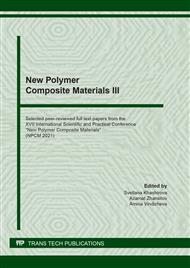[1]
A.G. Olabi, T. Wilberforce, M.A. Abdelkareem, Fuel cell application in the automotive industry and future perspective, Energy. 214 (2021) 118955.
DOI: 10.1016/j.energy.2020.118955
Google Scholar
[2]
Y. Wang et al., Materials, technological status, and fundamentals of PEM fuel cells–a review, Materials today. 32 (2020) 178-203.
DOI: 10.1016/j.mattod.2019.06.005
Google Scholar
[3]
Y. Song et al., Review on current research of materials, fabrication and application for bipolar plate in proton exchange membrane fuel cell, International Journal of Hydrogen Energy. 45 (2020) 29832-29847/.
DOI: 10.1016/j.ijhydene.2019.07.231
Google Scholar
[4]
N. Guo, M.C. Leu, Effect of different graphite materials on the electrical conductivity and flexural strength of bipolar plates fabricated using selective laser sintering, International journal of hydrogen energy. 37 (2012) 3558-3566.
DOI: 10.1016/j.ijhydene.2011.11.058
Google Scholar
[5]
D. Prasanna, V. Selvaraj, Cyclophosphazene based conductive polymer-carbon nanotube composite as novel supporting material for methanol fuel cell applications, Journal of colloid and interface science. 472 (2016) 116-125.
DOI: 10.1016/j.jcis.2016.03.032
Google Scholar
[6]
J. Zhu, Carbon black-reinforced 3D and 4D printable conductive polymer composites, 3D and 4D Printing of Polymer Nanocomposite Materials. Elsevier (2020) 367-385.
DOI: 10.1016/b978-0-12-816805-9.00012-0
Google Scholar
[7]
Y. Huang et al., Conductive polymer composites from renewable resources: an overview of preparation, properties, and applications, Polymers. 11 (2019) 187.
Google Scholar
[8]
L. Flandin et al., Effect of strain on the properties of an ethylene–octene elastomer with conductive carbon fillers, Journal of Applied Polymer Science. 78 (2000) 894-905.
DOI: 10.1002/(sici)1097-4628(20000509)76:6<894::aid-app16>3.0.co;2-k
Google Scholar
[9]
S. Shimpalee et al., Investigation of bipolar plate materials for proton exchange membrane fuel cells, International journal of hydrogen energy. 41 (2016) 13688-13696.
DOI: 10.1016/j.ijhydene.2016.05.163
Google Scholar
[10]
B.R. Caes et al., Biomass to furanics: renewable routes to chemicals and fuels, ACS Sustainable Chemistry & Engineering. 3 (2015) 2591-2605.
DOI: 10.1021/acssuschemeng.5b00473
Google Scholar
[11]
A. Mukherjee, M.J. Dumont, V. Raghavan, Sustainable production of hydroxymethylfurfural and levulinic acid: Challenges and opportunities, Biomass and Bioenergy. 72 (2015) 143-183.
DOI: 10.1016/j.biombioe.2014.11.007
Google Scholar
[12]
P.K. Rout et al., Synthesis of hydroxymethylfurfural from cellulose using green processes: A promising biochemical and biofuel feedstock, Chemical Engineering Science. 142 (2016) 318-346.
DOI: 10.1016/j.ces.2015.12.002
Google Scholar
[13]
N. Faddeev, V. Klushin, N. Smirnova, Bio-Based Anti-Corrosion Polymer Coating for Fuel Cells Bipolar Plates, Key Engineering Materials. 869 (2020) 413-418.
DOI: 10.4028/www.scientific.net/kem.869.413
Google Scholar
[14]
N. Faddeev et al., Bio-Based Conductive Polymer Composite Materials for Fuel Cells Bipolar Plates, Key Engineering Materials. 869 (2020) 591-596.
DOI: 10.4028/www.scientific.net/kem.869.591
Google Scholar
[15]
T.A. Blanchet, 13 Fluoroplastics, Handbook of Thermoplastics. 41 (2016) 397.
Google Scholar
[16]
K. Yao et al., Highly conductive and strong graphite-phenolic resin composite for bipolar plate applications, Energy & Fuels. 31 (2017) 14320-14331.
DOI: 10.1021/acs.energyfuels.7b02678
Google Scholar
[17]
V.A. Klushin et al., Technological aspects of fructose conversion to high-purity 5-hydroxymethylfurfural, a versatile platform chemical, Russian Journal of Organic Chemistry. 52 (2016) 767-771.
DOI: 10.1134/s1070428016060014
Google Scholar
[18]
J. Jin et al., Effects of Mo content on the interfacial contact resistance and corrosion properties of CrN coatings on SS316L as bipolar plates in simulated PEMFCs environment, International Journal of Hydrogen Energy. 43 (2018) 10048-10060.
DOI: 10.1016/j.ijhydene.2018.04.044
Google Scholar
[19]
T.A. Isakova, P.N. Petrova, Mechanical Properties of Polymer Composites Based On Modified Polytetrafluoroethylene, IOP Conference Series: Materials Science and Engineering. – IOP Publishing. 1079 (2021) 32-48.
DOI: 10.1088/1757-899x/1079/3/032048
Google Scholar
[20]
B.K. Kakati, K.R. Guptha, A. Verma, Fabrication of composite bipolar plate for proton exchange membrane fuel cell, J Environ Res Dev. 4 (2009) 202-211.
Google Scholar
[21]
Q. Yin et al., Study on the electrical and mechanical properties of phenol formaldehyde resin/graphite composite for bipolar plate, Journal of power sources. 165 (2007) 717-721.
DOI: 10.1016/j.jpowsour.2006.12.019
Google Scholar
[22]
K.K. Kar, R.K. Gautam, Synergistic effects of carbon fillers of phenolic resin based composite bipolar plates on the performance of PEM fuel cell, Fuel Cells. 16 (2016) 179-192.
DOI: 10.1002/fuce.201500051
Google Scholar
[23]
S.M. Chudinov, N.B. Brandt, Y.G. Ponomarev, Semimetals: 1. Graphite and its Compounds, Elsevier, (2012).
Google Scholar
[24]
I. Algaba, M.A. Rodríguez-Perez, M. Ardanuy, Electrical conductivity and mechanical properties of vapor-grown carbon nanofibers/trifunctional epoxy composites prepared by direct mixing, Composites Part B: Engineering. 42 (2011) 675-681.
DOI: 10.1016/j.compositesb.2011.02.006
Google Scholar


